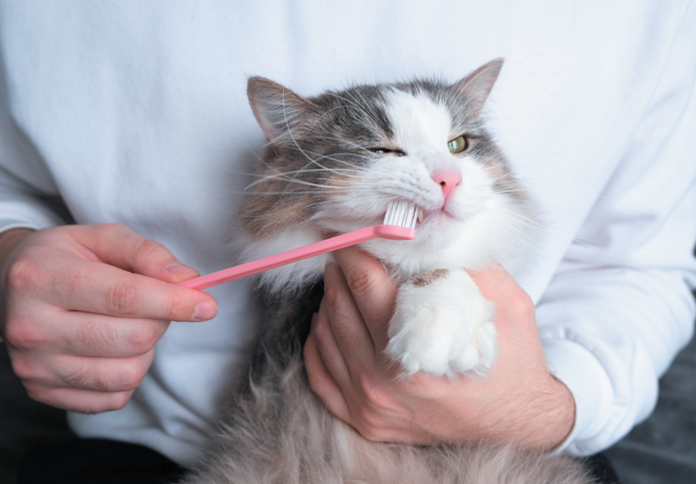Gum disease is the most common disease to affect pet cats. It may not sound like a big deal. But gum disease, known medically as periodontal disease, allows bacteria to enter the bloodstream, and that can lead to heart, lung, and kidney disease. That’s why it’s critical to take care of your cat’s teeth from the moment you adopt her — or to start today if you haven’t been doing so.
Unfortunately, too many cat owners let their cat’s teeth go, which is why 70 percent of our pets show signs of oral disease by the time they’re only 3 years old. The choice not to tend to a cat’s teeth is understandable. It takes patience to adjust your cat to letting you brush her teeth every day, and it takes money to bring her to the veterinarian once a year for a check-up and possibly to have her teeth cleaned of tartar below the gum line that you can’t reach with a toothbrush.
But think of your own mouth if you never brushed your teeth — or even if you didn’t brush them for only a couple of weeks. You wouldn’t want to get near yourself, and you’d literally be able to see gunk collecting at the juncture of the tooth and the gum. But what you couldn’t see developing would be even worse.
How gum disease wreaks havoc on a cat’s health
Gum disease is not about cavities. In fact, cats don’t get cavities. Their teeth don’t touch each other in a way that lets cavity-causing bacteria collect between them. And they don’t have little pits and fissures in their teeth (like we do) that serve as natural “wells” for cavities to form. The pH of their saliva inhibits cavity formation, too.
No, rather, gum disease is about the build-up of plaque, a sticky film that develops around the teeth. Plaque contains bacteria — they feed off it. When the plaque isn’t regularly removed by brushing, too much of it makes its way under the gum line and hardens into tartar, which cannot be scraped off at home. The more severe the cat’s gum disease becomes (the gums actually develop pockets that allow more bacteria to accumulate), the greater the chances that the bacteria that have colonized will make their way into the bloodstream and from there to other parts of the body. That’s why untreated gum disease paves the way for diseases of vital organs.
Some signs of dental disease you might expect: bad breath; red, swollen, or bleeding gums; dropping food from the mouth while eating. But others might not be as obvious. If you notice any of these signs, listed by the American Veterinary Dental College and the American Veterinary Medical Association, ask your veterinarian if gum disease or other dental diseases might have something to do with them.
➤ Poor grooming.
➤ Salivating.
➤ Decrease in or loss of appetite and attendant weight loss.
➤ Facial swelling.
➤ Discharge from the nose or eyes.
➤ Irritability. (Dental disease can prove quite painful.)
Managing your cat’s dental health
There are two things you can do to keep your cat’s teeth in the best shape possible and thereby avoid serious problems down the line.
- Brush your pet’s teeth at least every other day. Once a day is ideal, but once every other day will suffice, if necessary, because it takes two days for soft, sticky plaque to turn into hardened tartar (also called calculus) that brushing cannot remove. If you’ve never brushed your cat’s teeth before, it’s going to take patience to get her used to it. And by patience we mean months in some cases, not weeks. You want to start simply by rubbing and stroking her face while offering praise, then graduate to holding a toothbrush in one hand while stroking her face with the other. From there, put a delicious cat-flavored toothpaste on the brush (or even on her paw) and let her lick it off. Eventually, she’ll be ready to let you try actual brushing.
- Make sure your cat gets a veterinary dental check-up at least annually. Some years, the vet will recommend that your cat be put under anesthesia for a thorough evaluation and cleaning. (Even cats whose teeth are brushed every day develop some tartar, just like people do.) The dental disease that does the most serious damage occurs below the gum line and can’t be seen just by looking. And a cat is not going to sit still and open wide, which is why she needs to be put under.





HOW TO BRUSH A CAT’S TEETH? I HAVE FOUR AND DAILY BRUSHING WOULD TAKE SOMETIME… I ALSO HAVE A BAD BACK… NEGLECT ON THIS PART!!!!!!!!!!!!!!!!!!!!!!!
My cat is almost 17 and has no visible signs of gum or teeth issues. I realize issues could be below the gumline. I have fed him a Hills TD prescription diet all of his life to maintain his teeth, only give him quality treats and it has worked very well for him. He is a docile Norwegian Forest cat who I probably could have trained to accept brushing but I didn’t take on the challenge with two cats at the time. I wouldn’t want to put him under anesthesia now so will try to do better next time with a kitten. Thanks for the article.
One of my cats had his teeth cleaned the first time about 9 months ago. Things were ok then.
Recently he started jumping and snarling for no apparent reason. It sounds like a momentary cat fight, but he’s alone. He started losing his appetite and circling the food bowl like he was afraid to eat. Turns out he has periodontal disease. A shot of antibiotics has him acting normal again, but the vet says he’ll eventually have to get all of his teeth removed or be in a lot of pain. Removal can cost several thousand dollars. It’s that or… :-(. Enough to ruin my day.